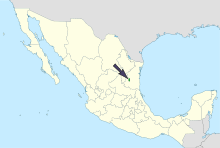Obregonia
Obregonia, the artichoke cactus, is a genus of cacti with a single species, Obregonia denegrii. The species is endemic to the state of Tamaulipas in Mexico.
| Obregonia | |
|---|---|
 | |
| Scientific classification | |
| Kingdom: | |
| (unranked): | |
| (unranked): | |
| (unranked): | Core eudicots |
| Order: | |
| Family: | |
| Subfamily: | |
| Tribe: | |
| Genus: | Obregonia Fric |
| Species: | O. denegrii |
| Binomial name | |
| Obregonia denegrii Fric | |
 | |
| Synonyms | |
|
Ariocarpus denegrii (Fric) Marshall | |
The genus Obregonia is named after Álvaro Obregón,[1] while the species is named after Ramon P. De Negri, who was the Minister of Agriculture of Mexico when the cacti was first described by Alfred Frec in 1923.[2]
Description
This rare species resembles an inverted green pine cone with a woolly center. It grows slowly in culture and requires little water. It benefits from full sun and is multiplied by seed. It is very slow growing.
It is an IUCN Red List Endangered species.
Uses
The Nahuatl Indians call the plant peyotl, and it is said to have hallucinogenic alkaloids.[2] It is one of the closest living relatives of the genus Lophophora.[3]
Gallery
- Obregonia denigrii in flower
- Obregonia denigrii seen from above
- The flower of Obregonia denigrii
- Cultivated plant specimen
References
- Eggli, Urs et al. (2004). Etymological Dictionary of Succulent Plant Names, p. 169, 64., p. 169, at Google Books
- Venning, Frank D. Cacti (A Golden Guide). Racine, Wisconsin: Western Publishing Company, Inc. p. 153.
- Anderson, Miles (2008). The Complete Illustrated Guide to Growing Cacti & Succulents. London: Lorenz Books. p. 94. ISBN 9780754818427.
- Anderson; et al. (2002). "Obregonia denegrii". IUCN Red List of Threatened Species. 2002. Retrieved 5 May 2006.CS1 maint: ref=harv (link) — Database report on species & threats.
- .]]
